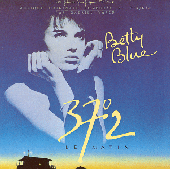Gabriel Yared's most
famous score, The English Patient was a bit of a disappointment
for a lack of any substantial thematic/melodic material
although the film was a huge success and won nine Academy
awards.
His best effort to date
is Betty Blue. The collaboration Beneix/Yared produced a
'classic' which still is very enjoyable to watch nearly
twenty years after its first release.
At times, it seems, there
is a mysterious alchemy at work when the vision of a director
blends perfectly well with a composer's world, and where
the result is more than the sum of the parts. To name but
a few: Hitchcock/Herrmann, Leone/Morricone, Fellini/Rota
collaborative works come to mind at once.
In Betty Blue, Gabriel
Yared has managed to create a score which totally belongs
to Beneix's vision (or may be this is the other way round).
vision (or may be this is the other way round).
Betty Blue is a tale
of love and destruction where the main character - larger
than life Betty Blue can't stand a world - ours -
where love can't transcend all the pettiness and mediocrity
of our daily lives. The film depicts her gradual disillusionment
and her final brutal escape into madness and ultimately
death. This is a love story of nearly mythical proportions
and through the use of his thematic material and orchestrations
Yared has cleverly driven this point to the audience.
The main theme " Betty
and Zorg" is used many times during the film, played with
synthesizers or with the melody given to a sax. It is a
soft, romantic tune, a little bit sad.
The second important
theme appears at a crucial moment of the film. In the piano
shop, in the dark, Zorg starts to play a somehow disjointed
pattern/groove and discreetly Betty joins in with slightly
off key repeated note which complements the first pattern
to create a haunting piece. The slightly awkward musical
elements, not particularly interesting on their own, make
sense when they are put together. That is exactly how these
two characters are. From the point of view of society, they
seem to be two slightly maladjusted persons or even two
misfits but, when they are together, they form a marvellous
couple.
In the third key track
Gabriel Yared uses the barrel organ very cleverly.
In this film the barrel
organ has two important connotations:
In France, a similar
tune was used for many years as a signature tune for an
extremely popular cine-club television program with a strong
emphasis on the films made before the war (Renoir, René
Clair, etc...)*
So, in using such a piece
of music, Beneix placed his story in a context which is
not realistic, but belongs to the realm of legend or of
popular modern tale. This is a statement aiming at convincing
us that, we, the spectators, are going to watch one of these
popular epics with characters larger than life as we could
find in Carné's films (les Enfants du paradis, Hotel
du Nord, etc...). In fact the story is told - as an
immense flashback by one of the main protagonists, Zorg,
who is a writer.
In France as in England,
the barrel organ is linked with the street story tellers,
singers who used to give , during the XIXth century and
in the XXth century until the war, street renditions of
popular never ending serial stories.
Obviously this tradition
is at the source of the barrel organ cinematic tradition.

